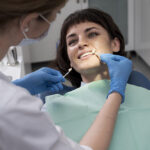Oral health is fundamental for the general well-being of the body, and one of the problems that can affect the oral cavity is pericoronitis.
Despite being a common condition, many people are still unaware of this disease and its effects on the body. In this article, we are going to discuss pericoronitis, from what it is to its causes and treatments.
It is important for everyone to know how to identify and treat pericoronitis to maintain good oral health.
What is Pericoronitis?
Pericoronitis is commonly associated with wisdom teeth, the last molars to erupt in the mouth, which usually appear between the ages of 17 and 25.
Pericoronitis is a common condition in which the gum tissue around the wisdom teeth becomes inflamed. It occurs when the wisdom tooth cannot fully emerge from the gum and therefore ends up partially retained. This creates a pocket that collects food debris and bacteria, causing inflammation and pain.
Pericoronitis can be acute or chronic, and its symptoms include pain, redness, swelling, and bad breath. In some cases, a more serious infection can occur that extends beyond the mouth and can affect other parts of the body.
The condition is most common in young adults, when wisdom teeth are starting to come in, but it can occur at any age.
It is important to be aware of pericoronitis so that it can be diagnosed and treated early. When untreated, pericoronitis can progress to more serious infections, affecting the patient's oral and general health.
In addition, it is important to know the causes of pericoronitis and how to prevent it. Maintaining good oral hygiene, having regular dental appointments and assessing the need for wisdom teeth removal are some of the measures that can help prevent pericoronitis.
Therefore, by understanding what pericoronitis is and its importance, it is possible to take preventive measures and seek treatment when necessary, ensuring up-to-date oral and general health.
Why does pericoronitis occur?
Pericoronitis occurs when there is a buildup of bacterial plaque and food in the region around the partially erupted wisdom tooth. Plaque is a sticky layer of bacteria that forms on teeth and gums, and if not removed properly, it can lead to gum inflammation and infection.
In some cases, pericoronitis can occur due to a misaligned bite, which puts additional pressure on the wisdom tooth area, making it more difficult to clean properly.
Now that you know more about the definition and characteristics of pericoronitis, as well as the location of the wisdom tooth and the main causes of inflammation, it is important to be aware of the symptoms and look for a dentist if you experience pain or swelling in the gum area.
Remember that prevention is the best way to avoid pericoronitis, and good oral hygiene, including regular cleaning of your wisdom teeth, can help prevent this condition.
What are the symptoms of pericoronitis?
The main symptoms of pericoronitis include:
- toothache
- gum inflammation and redness
- difficulty opening the mouth
- bad breath
- fever and general malaise
The pain is usually more intense in the affected area and may extend to the jaw and neck. Gum inflammation and redness is caused by the accumulation of bacteria and food debris in the area, which can lead to the formation of abscesses.
Difficulty opening your mouth is caused by gum swelling, which can affect jaw movement. Bad breath is a result of the accumulation of bacteria in the affected region and can become a chronic problem if not treated properly.
Fever and general malaise are less common symptoms, but can indicate a more serious infection.
It is important to seek dental help as soon as symptoms of pericoronitis appear. Treatment may include antibiotics to fight the infection, anti-inflammatories to relieve pain and inflammation, and in more severe cases, surgery may be required to remove the wisdom tooth.
Remember that prevention is always the best option, and maintaining good oral hygiene and regular visits to the dentist can help you avoid pericoronitis and other unpleasant dental conditions.
Diagnosis and treatment of pericoronitis
The diagnosis of pericoronitis is performed by a dentist through a clinical and radiographic examination.
During the clinical examination, the dentist will evaluate the area around the wisdom tooth, looking for signs of inflammation and redness in the gum, presence of pus, swelling and other symptoms associated with pericoronitis.
In addition, the dentist may order x-rays to assess the position of the wisdom tooth and the extent of inflammation. With this information, the dentist can determine whether pericoronitis is in an early or advanced stage and define the best approach for treatment.
It is important to seek dental care as soon as symptoms of pericoronitis appear so that the diagnosis is made as early as possible and treatment can be started quickly.
Early treatment can help prevent more serious complications and reduce the discomfort and pain associated with pericoronitis.
Treatment of pericoronitis
When it comes to treating pericoronitis, it's important to seek professional help right away. Early treatment can help alleviate symptoms and prevent more serious complications.
Treatment for pericoronitis depends on the severity of the inflammation. In mild cases, the dentist may simply prescribe antibiotics and pain relievers to control pain and swelling. However, in more severe cases, it may be necessary to extract the affected wisdom tooth.
During treatment, it is important to maintain good oral hygiene and follow the dentist's instructions. This may include mouthwashes with antibacterial solutions, hot or cold packs on the affected area, and avoiding hard or sticky foods.
In some cases, surgery may be necessary to remove excess gum that is causing inflammation. In other cases, it may be necessary to make an incision to drain the accumulated pus at the site.
It is important to remember that the treatment of pericoronitis must be carried out by an experienced and qualified dentist. If you have symptoms of pericoronitis, contact our team to schedule an appointment and receive the appropriate treatment.
Pericoronitis care and prevention
While it is possible to treat pericoronitis, the best way to deal with this condition is to prevent it. Here are some precautions and preventive measures you can take to avoid pericoronitis:
– Maintain good oral hygiene: Daily brushing and flossing are key to preventing pericoronitis. Additionally, using mouthwash can help kill bacteria that cause oral disease.
– Visit the dentist regularly: a dental checkup is the best way to ensure your mouth is healthy and catch any problems early. The dentist can also help monitor the eruption of wisdom teeth and prevent pericoronitis.
– Perform wisdom tooth extraction: if your dentist determines that your wisdom tooth needs to be extracted, it is important to follow post-operative care instructions to help prevent pericoronitis.
– Avoid hard or sticky foods: chewing hard or sticky foods can irritate the gum around the wisdom tooth and lead to pericoronitis.
– Maintain a healthy diet: a balanced, nutrient-rich diet is essential for oral and general health. Consume foods rich in calcium and vitamin D, as they are essential for healthy teeth and bones.
Adopting these care and preventive measures can help prevent pericoronitis and keep your oral health up to date. Remember, if you notice any symptoms of pericoronitis, it's important to see a dentist right away to get proper treatment.
Follow-up after wisdom tooth extraction
Follow-up after wisdom tooth extraction is an important step in the treatment of pericoronitis. After the procedure, the dentist should advise the patient on the necessary care for healing and prevention of complications.
It is common for the patient to experience pain and swelling after the extraction, so the dentist can prescribe painkillers and anti-inflammatory drugs to relieve symptoms. In addition, it is important for the patient to follow the dentist's instructions on oral hygiene, avoiding brushing in the extraction area during the first few days and rinsing with warm water and salt.
Follow-up after wisdom tooth extraction can be done at follow-up appointments, in which the dentist will assess healing and possible signs of infection or other complications. The number of consultations may vary according to the severity of the case and the need for individualized follow-up.
In addition to the follow-up after wisdom tooth extraction, it is important that the patient maintains good oral hygiene and avoids smoking and consuming very hard or hot foods during the recovery period. These measures help prevent pericoronitis and other complications related to wisdom tooth extraction.
By following the dentist's guidelines and maintaining an adequate care and prevention routine, it is possible to prevent the recurrence of pericoronitis and other complications related to the wisdom tooth. Proper follow-up also ensures the patient's quick and effective recovery, preserving their oral health and general well-being.
Conclusion
In summary, pericoronitis is a common condition that can affect people with erupting wisdom teeth. It is important to recognize the symptoms and seek help from a dental professional for proper diagnosis and treatment.
With the follow-up of an expert, it is possible to relieve symptoms and prevent more serious complications.
Take care of your oral health and smile with confidence!
Did you like our article? So enjoy your visit to the blog and read the article Dental check-up: why is it important and what is part of it? Find out now!
Did you like this information? then follow the Odonto Liuzzi on social networks to receive more interesting content like this!










 per
per